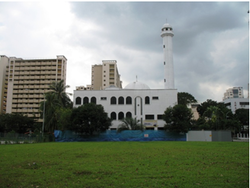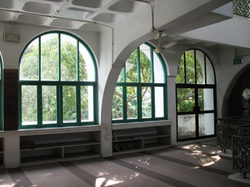A Mosque
Address: 76 Kim Keat Road

Side view of the Mosque (taken 19 Jan 2011)
History
On 26 December 1959, Muslim residents from the Kebun Limau area gathered to discuss the need for a surau (Muslim prayer hall) in the vicinity and formed a committee in-charge of its construction. With the approval of the government, they obtained a temporary occupancy of the land (TOL) of 573 square metres.
The Management Committee, appointed on 19 November 1961, decided to get donations of $20 from every Muslim family living there. Construction started in mid-1964, and the surau was a simple two-storey building, first of its kind there. It was named Masjid Kebun Limau after the area. Efforts were made to transform it into a mosque in 1973, for the increasing Muslim community there to have a permanent place for worship. The Management Board, appointed in 1975, organised activities like religious classes. They were interested in buying the site of the mosque after expiry of the TOL and wanted to expand to accommodate the increasing Muslims population there.
The Board was allowed to conduct fundraising events for its expansion, so the reconstruction fund was established to collect donations, aiming to collect $600,000 over two-and-a-half years. In June 1979, the Board was given an offer to buy the land of 1376 square meters and appealed for an additional 474 square meters.
In 1981, after many fundraising events, the Board received a donation of $100,000 from a Mecca-based organisation, rounding up the donations to almost the estimated goal. In September, Mrs Hajjah Rahimabi Ahmad Angullia donated $1,600,000 to the mosque, in memory of her daughter. She came from a prominent Indian Muslim family called the Angullia, who has made substantial contributions to the Muslim community like the construction of Angullia Mosque and Angullia Park. With her large donation, the mosque collected about $2,100,000. A mosque was then built on the existing plot and renamed Masjid Hajjah Rahimabi Kebun Limau in honour of her generosity.
On 26 December 1959, Muslim residents from the Kebun Limau area gathered to discuss the need for a surau (Muslim prayer hall) in the vicinity and formed a committee in-charge of its construction. With the approval of the government, they obtained a temporary occupancy of the land (TOL) of 573 square metres.
The Management Committee, appointed on 19 November 1961, decided to get donations of $20 from every Muslim family living there. Construction started in mid-1964, and the surau was a simple two-storey building, first of its kind there. It was named Masjid Kebun Limau after the area. Efforts were made to transform it into a mosque in 1973, for the increasing Muslim community there to have a permanent place for worship. The Management Board, appointed in 1975, organised activities like religious classes. They were interested in buying the site of the mosque after expiry of the TOL and wanted to expand to accommodate the increasing Muslims population there.
The Board was allowed to conduct fundraising events for its expansion, so the reconstruction fund was established to collect donations, aiming to collect $600,000 over two-and-a-half years. In June 1979, the Board was given an offer to buy the land of 1376 square meters and appealed for an additional 474 square meters.
In 1981, after many fundraising events, the Board received a donation of $100,000 from a Mecca-based organisation, rounding up the donations to almost the estimated goal. In September, Mrs Hajjah Rahimabi Ahmad Angullia donated $1,600,000 to the mosque, in memory of her daughter. She came from a prominent Indian Muslim family called the Angullia, who has made substantial contributions to the Muslim community like the construction of Angullia Mosque and Angullia Park. With her large donation, the mosque collected about $2,100,000. A mosque was then built on the existing plot and renamed Masjid Hajjah Rahimabi Kebun Limau in honour of her generosity.

Interior of the mosque (taken 19 Jan 2011)
Information
This year, the mosque is undergoing renovation works, expected to complete in September. Today, the mosque still faces a shortage of donations needed to maintain its operations. The donations come from mainly internal events held and organised by the mosque like tuition classes, $10 coupons for meals, wakaf donations and the bazaar held during Ramadan.
The mosque is run and managed by a Management Committee of 14 board members and several volunteers appointed by MUIS. The activities organised include tuition classes for low-income families and religious lectures. The mosque also conducts weddings and prayers five times a day.
During Hari Raya Puasa and Hari Raya Haji, prayers are performed and there are celebrations. During the latter, a bazaar is organised with media coverage. The slaughtering of sacrificial animals is also held, with the sacrificial meat being distributed to low-income families.
This year, the mosque is undergoing renovation works, expected to complete in September. Today, the mosque still faces a shortage of donations needed to maintain its operations. The donations come from mainly internal events held and organised by the mosque like tuition classes, $10 coupons for meals, wakaf donations and the bazaar held during Ramadan.
The mosque is run and managed by a Management Committee of 14 board members and several volunteers appointed by MUIS. The activities organised include tuition classes for low-income families and religious lectures. The mosque also conducts weddings and prayers five times a day.
During Hari Raya Puasa and Hari Raya Haji, prayers are performed and there are celebrations. During the latter, a bazaar is organised with media coverage. The slaughtering of sacrificial animals is also held, with the sacrificial meat being distributed to low-income families.
Titbit Corner...
Kebun Limau - Citrus Haven
The area Kebun Limau, which means citrus fruit garden, was named as such due to the citrus fruit gardens that once grew there. The area stretches horizontally from the present-day Saint George's Road (near Boon Keng) to Balestier Road and vertically from Kim Keat Road to McNair Road. Today, what remains of this legacy is Jalan Kebun Limau as most of the estate, including the entire of Rayman Estate, was cleared to make way for the Central Expressway (CTE).
Uniqueness of the Mosque
This mosque is one of the few mosques in Singapore which have pulpits decorated with woodcarvings. The pulpit and grandfather clocks located in the main prayer hall on the first floor has been around since the construction of the mosque in the 1980s.
Kebun Limau - Citrus Haven
The area Kebun Limau, which means citrus fruit garden, was named as such due to the citrus fruit gardens that once grew there. The area stretches horizontally from the present-day Saint George's Road (near Boon Keng) to Balestier Road and vertically from Kim Keat Road to McNair Road. Today, what remains of this legacy is Jalan Kebun Limau as most of the estate, including the entire of Rayman Estate, was cleared to make way for the Central Expressway (CTE).
Uniqueness of the Mosque
This mosque is one of the few mosques in Singapore which have pulpits decorated with woodcarvings. The pulpit and grandfather clocks located in the main prayer hall on the first floor has been around since the construction of the mosque in the 1980s.
